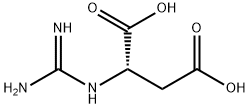6133-30-8
 6133-30-8 結(jié)構(gòu)式
6133-30-8 結(jié)構(gòu)式
基本信息
L-胍基丁二酸
2-胍基琥珀酸
(S)-2-胍基琥珀酸
n-amidino-asparticaci
GUANIDINOSUCCINIC ACID
2-Guanidinosuccinic acid
N-AMIDINO-L-ASPARTIC ACID
(S)-GUANIDINOSUCCINIC ACID
alpha-guanidinosuccinicacid
(S)-2-Guanidinosuccinic acid
N-carbamimidoyl-L-aspartic acid
n-(aminoiminomethyl)-l-asparticaci
物理化學(xué)性質(zhì)
常見問題列表
|
Human Endogenous Metabolite
|
Guanidinosuccinic acid, a constituent of normal urine, is elevated in the urine and serum of azotemic patients. Guanidinosuccinic acid (GSA), a guanidino compound found to be greatly increased in uremia, is administered by intraperitoneal (i.p.) injection to adult albino mice and to young mice 7, 14 and 21 days old. Epileptogenic and toxic properties are assessed and Guanidinosuccinic acid brain levels following i.p. injection ae determined. In adult mice, Guanidinosuccinic acid induces long-lasting generalized clonic and clonic-tonic convulsions in a dose-dependent manner with a CD 50 (and 95% confidence interval) of 363 (287-458) mg/kg (n=35), and an LD 50 of 579 (445-756) mg/kg. The CD 50 of Guanidinosuccinic acid corresponded with a brain concentration of 56 nmol/g tissue. Electrocorticographic recording in five adult mice revealed epileptiform discharges (spikes, spike-waves, and polyspike-waves) which appeared concomitant with the convulsions, When young mice are i.p. injected with a (for adults) subconvulsive dose of Guanidinosuccinic acid (250 mg/kg), an age-dependent decrease is noted in Guanidinosuccinic acid-induced convulsions and in the resulting brain concentration.